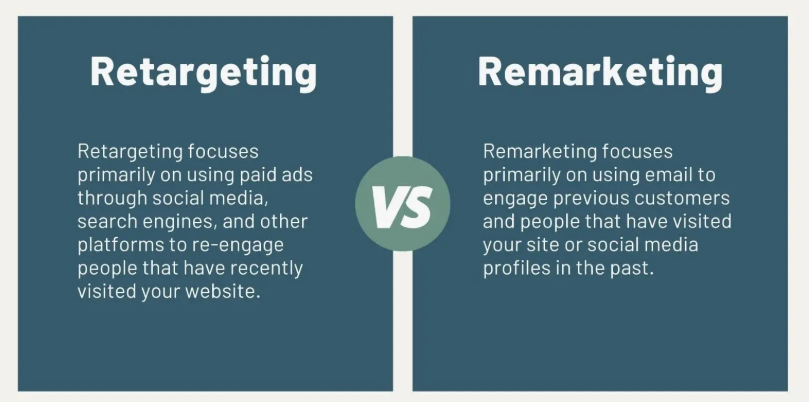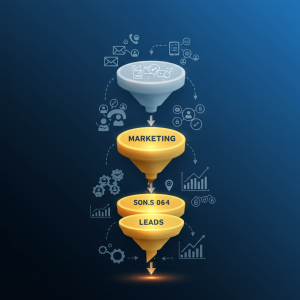Remarketing vs. Retargeting: Strategic Differences and Implementation

The digital marketing landscape is filled with terms that often get used interchangeably, creating confusion even among seasoned professionals. Perhaps no pair of tactics generates more terminological uncertainty than remarketing and retargeting. While both strategies focus on re-engaging prospects who’ve previously interacted with your brand, meaningful differences in their approach, implementation, and optimal use cases exist. Understanding these nuances can dramatically improve campaign performance and resource allocation.
Beyond the Terminology Confusion
The confusion between remarketing and retargeting stems partly from how major platforms label their services. Google, for instance, calls its ad-based re-engagement strategy “remarketing” while Facebook refers to similar functionality as “retargeting.” This inconsistent industry terminology has blurred what were originally distinct approaches to prospect re-engagement.
In their purest forms, these strategies developed from different starting points. Retargeting emerged from display advertising technology, focusing primarily on serving ads to users who visited specific web pages without converting. Remarketing grew from email marketing roots, centered on re-engaging known contacts based on specific actions or inactions they’d taken.
Today, the technical capabilities supporting both approaches have evolved significantly, yet understanding their foundational differences helps marketers determine which strategy—or which blend of both—best serves specific business objectives.
Retargeting: Pixel-Based Pursuit
At its core, retargeting operates through cookie or pixel technology that tracks anonymous website visitors as they browse the internet. When someone visits your product page but leaves without purchasing, retargeting platforms identify that browser later on other websites and display relevant ads encouraging return to complete the purchase.
The defining characteristics of retargeting include:
Immediate Engagement With Unknown Visitors
Retargeting excels at maintaining brand presence with people who haven’t yet identified themselves to your business. These prospects remain essentially anonymous—you know their browsing behavior but not necessarily their names or contact information. This capability makes retargeting particularly valuable for consumer products with shorter decision cycles and businesses with high website traffic but lower conversion rates.
The jewelry retailer Blue Nile provides an excellent implementation example. After browsing specific engagement ring styles on their website, visitors encounter precisely targeted display ads showing the exact rings they viewed while visiting other websites. This immediate connection between browsing behavior and advertising content creates powerful purchase intent reinforcement during crucial decision-making periods.
Visual Focus and Brand Reinforcement
Traditional retargeting relies heavily on visual elements to trigger recognition. Display banners, product images, and branded creative remind prospects of their previous interest. This visual emphasis makes retargeting particularly effective for products and services where aesthetic considerations influence purchase decisions.
The strategy works by creating multiple lightweight touch points across various websites, gradually building familiarity and keeping options top-of-mind without requiring significant attention investment from prospects. This ambient presence helps overcome the initial hesitation that prevented immediate conversion.
Cross-Channel Pursuit
Modern retargeting has evolved beyond simple display advertising to include social media platforms, video pre-roll, and even connected TV environments. This omnichannel approach ensures consistent messaging reaches prospects regardless of their media consumption habits. The technical implementation typically involves placing platform-specific pixels on key website pages, creating custom audiences based on page visits or specific interactions, and developing creative assets tailored to each channel’s specifications.
At BrandsDad, we’ve observed particularly strong performance when retargeting campaigns employ sequential messaging strategies that evolve as prospects encounter multiple ads. Rather than showing identical creative repeatedly, these progressive sequences address different aspects of value proposition or objection handling with each new exposure.
Remarketing: Relationship-Based Re-engagement
While retargeting focuses primarily on anonymous website visitors, remarketing traditionally centers on re-engaging known contacts through more personal channels. The strategy builds upon existing relationships, leveraging known information about prospects to deliver highly relevant messaging.
The distinguishing elements of remarketing include:
Communication With Identified Prospects
Remarketing campaigns typically engage people who have already shared contact information or completed specific actions that identify them. These might include email subscribers, previous customers, abandoned cart users who entered email addresses, or service quote requesters. This identified nature enables more personalized communication than possible with cookie-based retargeting alone.
The travel industry demonstrates remarketing’s effectiveness particularly well. When travelers research specific destinations on sites like Expedia and provide email addresses for price alerts, they subsequently receive highly personalized emails showcasing not just the destinations they explored but specific properties, flight options, and activities matching their browsing patterns and price preferences.
Multi-Channel Orchestration
While email often serves as remarketing’s foundation, sophisticated campaigns orchestrate multiple channels including SMS, direct mail, app notifications, and customer service outreach. This orchestration creates consistent experiences across touchpoints, reinforcing key messages while respecting channel preferences.
The implementation typically requires integration between customer data platforms, marketing automation systems, and communication delivery tools. These technical connections enable triggered communication based on specific behaviors, time delays, or sequential actions.
Behavioral Segmentation and Lifecycle Position
Effective remarketing relies heavily on behavioral segmentation rather than demographic targeting. Communications adjust based on specific actions prospects have taken or not taken, their position in the customer lifecycle, and their engagement patterns with previous communications.
A software company might implement this through different remarketing streams for prospects who started free trials versus those who only downloaded educational content. Trial users might receive feature-focused onboarding emails highlighting unused capabilities, while content downloaders receive case studies demonstrating business impact. Both serve remarketing’s re-engagement purpose but recognize the significant difference in relationship stage.
Strategic Implementation Differences
Beyond their technical foundations, remarketing and retargeting operate most effectively with different strategic approaches to creative development, timing, and performance measurement.
Creative Strategy Variations
Retargeting typically employs broader messaging that reinforces brand positioning and product benefits without assuming deep familiarity with offerings. The creative often focuses on visual recognition, reminding prospects of specific products or services they viewed while adding light emotional triggers or promotion elements.
Remarketing creative generally assumes greater knowledge of offerings and can address more specific benefits, objections, or implementation details. This deeper-level messaging acknowledges the existing relationship and builds upon previous interactions rather than simply reminding prospects of your existence.
For example, a furniture retailer’s retargeting might show images of sofas someone browsed with simple messaging about quality and delivery options. Their remarketing emails to the same prospect might address specific concerns like “Still wondering if this sofa will fit your space? Here’s our room planning guide” or “Prefer different upholstery options? View all 12 fabric choices here.”
Timing and Frequency Considerations
Retargeting typically begins immediately after website visits and continues for defined periods—often 7-30 days depending on sales cycle length. Frequency capping becomes critical to prevent oversaturation and potential brand damage from excessive ad exposure.
Remarketing sequences often employ more deliberate timing based on behavioral psychology and typical decision cycles. Communications might begin immediately after triggering actions but then follow planned intervals designed to respect decision-making processes while maintaining engagement.
Implementation of these timing differences requires attention to platform-specific settings. Retargeting platforms need appropriate frequency caps and duration limits, while remarketing automation requires carefully designed workflows with appropriate delays between communications.
Measurement Framework Differences
Performance measurement approaches differ significantly between these strategies, reflecting their different objectives and implementation methods.
Retargeting campaigns typically focus on return on ad spend (ROAS), view-through conversions, and assisted conversion metrics. The attribution models often emphasize exposures across multiple sites and platforms, recognizing retargeting’s role in nurturing consideration rather than simply driving immediate clicks.
Remarketing measurement tends toward engagement metrics like open rates and click-through rates alongside ultimate conversion analysis. Attribution usually examines the impact of specific message sequences and timing patterns rather than individual ad impressions.
Sophisticated organizations implement unified measurement frameworks that recognize how these strategies complement each other within broader customer journeys. These holistic approaches prevent internal competition between channels while providing accurate assessment of each tactic’s contribution to overall conversion paths.
Integration Approaches for Maximum Impact
While understanding the differences between remarketing and retargeting helps clarify strategic decisions, the most effective digital marketing programs integrate both approaches within cohesive re-engagement strategies. Several integration patterns demonstrate particular effectiveness.
Sequential Coordination
Many successful programs begin with retargeting to maintain presence with anonymous website visitors, then transition to remarketing once prospects identify themselves through email signups, content downloads, or other conversion actions. This seamless progression maintains continuous engagement while leveraging the increasing information available as relationships develop.
Implementation requires careful technical coordination between advertising platforms and marketing automation systems. Conversion pixels must accurately remove identified prospects from anonymous retargeting audiences while simultaneously triggering appropriate remarketing sequences.
Audience Segmentation Across Channels
Another effective approach segments audiences based on engagement depth and knowledge of offerings, then deploys retargeting and remarketing simultaneously to different segments. New visitors might receive awareness-focused retargeting while known prospects receive remarketing communications addressing specific consideration factors.
This implementation demands sophisticated audience management capabilities that maintain separate pools for different engagement strategies while preventing message conflicts or oversaturation across channels.
Message Reinforcement Between Channels
Perhaps the most advanced integration approach coordinates messaging across retargeting and remarketing channels to create deliberate reinforcement patterns. Email remarketing might introduce detailed product information while simultaneous retargeting visually reinforces key points from those emails.
Technical implementation requires careful creative coordination and timing alignment between platforms that typically operate independently. The complexity increases with the number of channels involved but so does the potential impact on conversion rates.
Implementation Considerations
Successful implementation of either strategy—and particularly their integration—requires attention to several critical factors that influence performance and compliance.
Privacy Regulation Compliance
Both remarketing and retargeting face increasing privacy regulation scrutiny. Implementation must account for GDPR, CCPA, and other regional privacy frameworks through appropriate consent mechanisms, data processing agreements, and transparency around tracking technologies.
Retargeting faces particular challenges from cookie deprecation and tracking prevention technologies. Implementation increasingly requires consideration of alternative identification approaches like first-party data activation and contextual targeting as complements to traditional cookie-based methods.
Exclusion Strategy Importance
Both strategies benefit from thoughtful exclusion rules that prevent continued messaging after conversion occurs. Nothing damages campaign efficiency more than remarketing or retargeting to people who have already purchased the advertised products. Implementation should include conversion tracking that promptly removes converted prospects from campaign audiences.
Similarly, strategic exclusion of certain segments—like price-sensitive one-time purchasers or tire-kickers who repeatedly engage without converting—improves overall campaign performance. These exclusions require regular data analysis to identify patterns warranting audience refinement.
Creative Refreshment Cadence
Both strategies suffer diminishing returns when creative assets remain static too long. Implementation should include planned refreshment cycles that introduce new messaging, visual elements, and offers before audience fatigue develops.
Retargeting typically requires more frequent creative rotation due to higher impression volume per person, while remarketing benefits from seasonal refreshes and alignment with broader marketing calendar events.
Conclusion
While remarketing and retargeting share the common goal of re-engaging prospects who’ve shown interest but not converted, their different approaches offer complementary strengths. Retargeting excels at maintaining presence with anonymous visitors through visual reinforcement across the web, while remarketing builds deeper relationships with identified prospects through more personalized, behavior-driven communications.
Understanding these strategic differences enables more thoughtful implementation decisions and better resource allocation. Rather than treating them as interchangeable tactics or competing for the same budget, sophisticated marketers develop integrated strategies leveraging both approaches within comprehensive customer journey frameworks.
The organizations achieving the greatest success recognize that the terminology matters less than understanding how each approach serves specific re-engagement objectives. By focusing on these strategic distinctions rather than getting lost in inconsistent industry terminology, marketers can develop nuanced re-engagement programs that meet prospects with the right message, in the right channel, at precisely the right moment in their decision journey.








